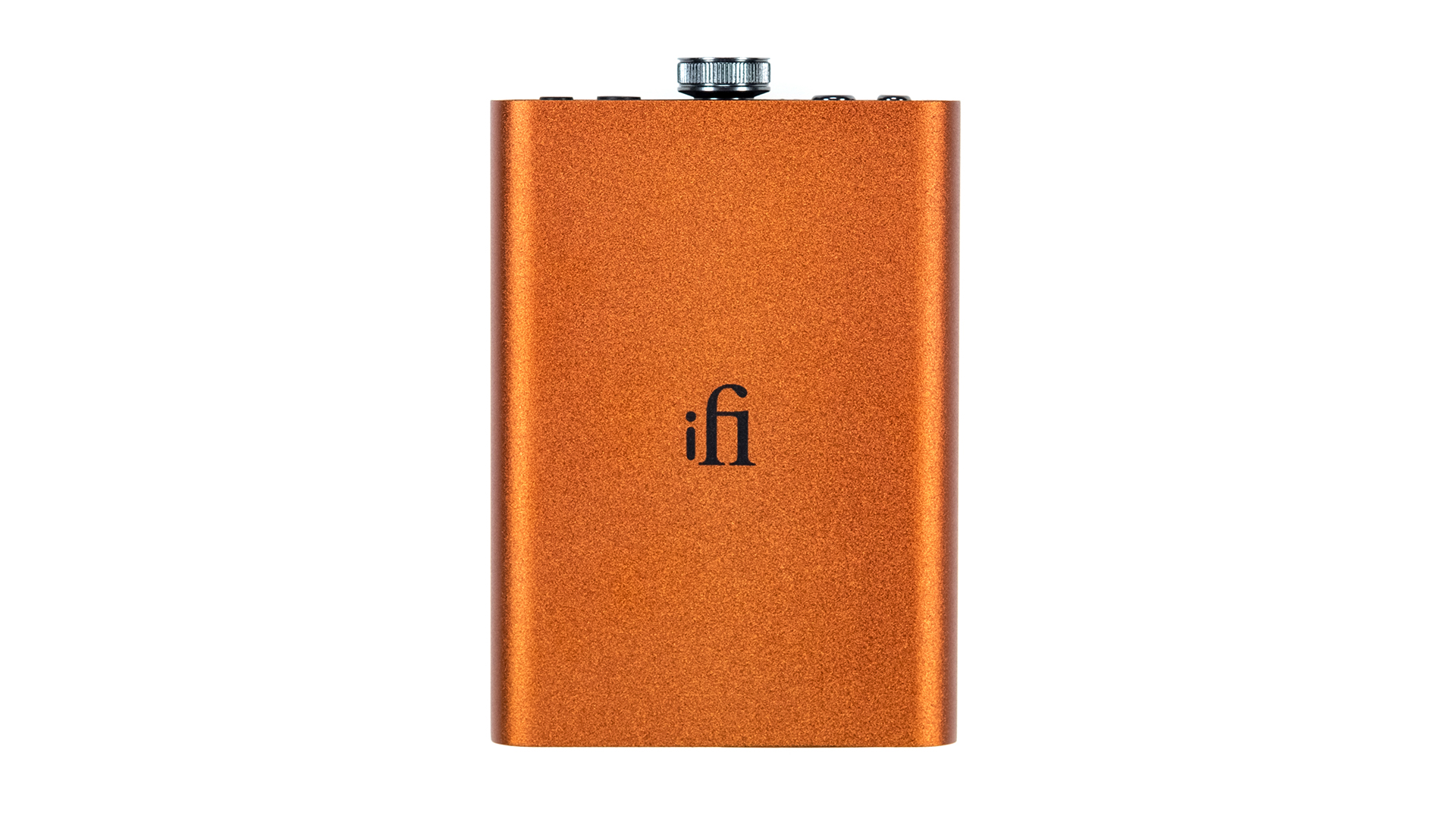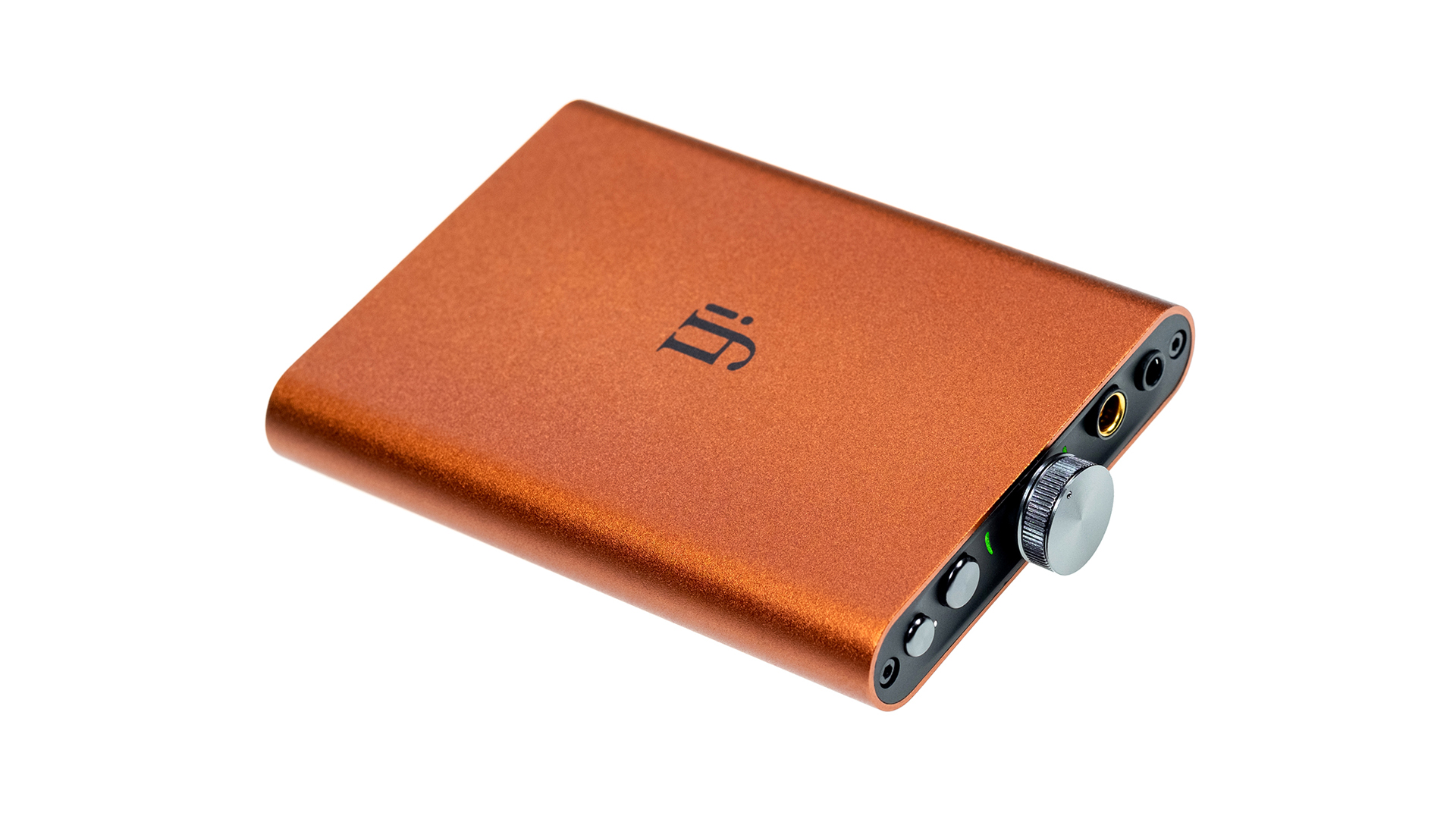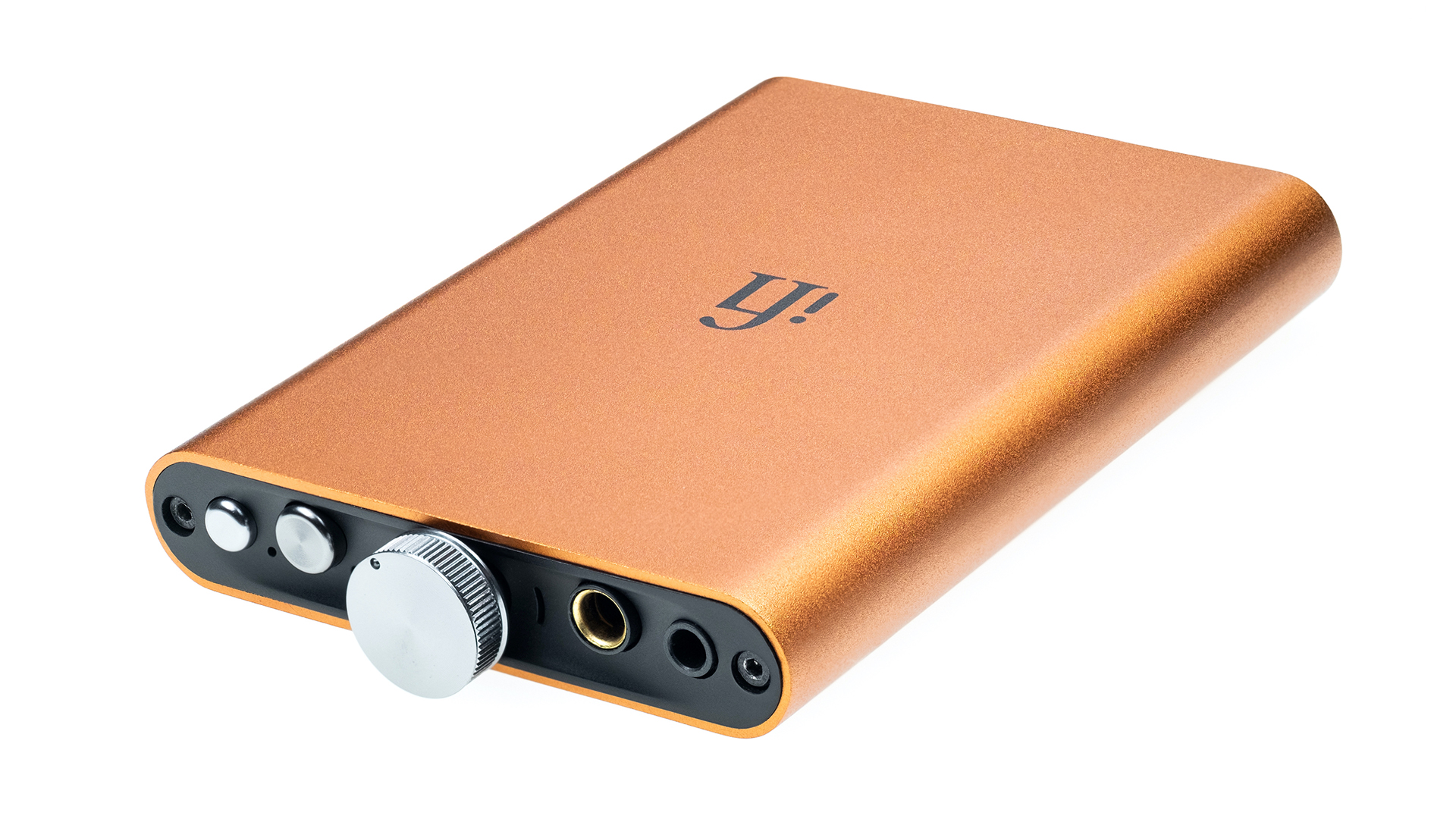What Hi-Fi? Verdict
Quality sound and impressive build for entry-level money – it may look like a hip flask, but iFi’s hip-dac 2 is the genuine article
Pros
- +
Zealous and agile sound
- +
Snappy, expansive bass
- +
Classy build and finish
Cons
- -
Nothing at this level
Why you can trust What Hi-Fi?
Given that the excellent original iFi hip-dac took apart the preconceptions anyone might have had on what a ‘serious’ portable DAC should look like, the chief difficulty faced by iFi with the hip-dac 2 sequel is surely the loss of novelty value. Upon unboxing the second-gen update, for example, we no longer exclaimed, “Ha! It really does look like a hip flask!”, although we did note the gorgeous new sunset orange paint job – a hue now more akin to an expensive single malt than a splash of petrol.
Elsewhere, it may look as if not much has changed, but of course, we need to delve a little deeper. The hip-dac 2’s new-generation 16-core XMOS chip boasts double the clock speed and four times the memory of its older sibling. It also houses an updated version of iFi’s GMT (Global Master Timing) circuitry, featuring a new crystal clock in a bid to further eradicate jitter in the digital-to-analogue conversion process. And partly thanks to that chip, there's now full three-fold MQA decoding – a point that will doubtless pique the interest of Tidal HiFi subscribers.
So, can iFi’s hip-dac 2 better the original and thus justify the slightly extra spend over its predecessor? We’re about to find out.
Price
Considering the inaugural hip-dac's 8-core XMOS chip (which processes the data received over USB) has now been replaced by a 16-core XMOS chip to boast four times the memory and the power to deliver full MQA decoding, the hip-dac 2’s £189 ($189, AU$279) asking price seems more than fair – generous, even. Yes, it’s dearer than the £149 ($149, AU$249) price point of the original (although a quick price scan reveals you can now pick one up for slightly less than the launch price, while stocks last), but you’re now getting the processor that was initially introduced in iFi’s higher-priced DACs, including its flagship (four times the price) iDSD Diablo, so the fact that the British firm’s premium tech has now trickled down to its more entry-level devices is something worth shouting about.
Build

As with the original, the iFi hip-dac 2 is a well-made unit. The extruded aluminium case, about the size of a pack of cards (or a small hip flask), fits nicely in the palm of your hand and feels deliciously cool, and the metal rotary volume dial (which doubles as the power switch and would be the cap of the bottle, if it were actually a hip flask) turns silently and has a lovely high-end feel.
On the hip-dac 2’s underside is a male USB Type A data input port. It may look a tad ungainly by today’s standards, but using this instead of the typical female option means that as well as offering a really secure connection that won’t fall out on your commute, or disconnect if it falls off your desk, the DAC can connect directly to Apple’s Lightning-to-USB (camera adaptor cable) for using your iPhone as a source. And that means easy, cost-effective access to Apple Music’s Hi-Res Lossless files. You’ll have to buy the Apple cable separately, but the hip-dac 2 does come bundled with three USB cables: a USB-C OTG (On-The-Go) cable, ideal for connecting Android devices and PCs/Macs with USB-C ports; a USB-A cable (for everything else); and a USB-A to USB-C for charging.

Finishes x 1
Battery life 8-12 hours
Formats supported DSD, DXD, PCM, MQA
Digital inputs USB 3.0
Headphone outputs 3.5mm, balanced 4.4mm
Dimensions (hwd) 1.4 x 7 x 10.2cm
Weight 125g
Across the top of the unit are two outputs – a conventional 3.5mm headphone jack and a balanced Pentaconn 4.4mm. The latter supposedly takes full advantage of the DAC’s differential amp design circuitry (something of a USP compared to most rivals) but, since our favourite headphones at this level all sport the traditional unbalanced connection, it is a novel rather than essential inclusion – albeit one that adds value, nonetheless.
The latest hi-fi, home cinema and tech news, reviews, buying advice and deals, direct to your inbox.
The hip-dac 2’s 2200mAh battery should, iFi says, last for eight to 12 hours of playing time, depending on volume level and how power-hungry the connected headphones are – and do take note here. Use a set of juice-guzzling Austrian Audio Hi-X55 over-ears and, naturally, the hip-dac 2 won’t last as long as it can when hooked up to the bijou SoundMagic E11C earbuds. During our testing, we got just over seven hours with the Austrian Audio over-ears and closer to the maximum claimed figure with the SoundMagic in-ears, on a full charge. Remaining stamina is denoted by a small LED under the USB Type C charging port, which is located next to the USB-A input on the base of the DAC. It glows white if you have more than 75 per cent in the tank, green for more than 25 per cent, red for more than 10 per cent, and flashes red when you need to charge it. When charging, the battery LED will flash on whatever colour you’re at – and you can continue listening while juicing it up.
Features

Flanking the volume knob on the opposite side to the headphone jacks are two buttons to help tailor the sound. From the outside in, first off is the PowerMatch button, which essentially changes the gain of the internal amp to make headphone matching easier. For in-ear headphones, iFi advises leaving it off, but for on- and over-ears, pressing the PowerMatch button on supplies the volume boost they need – and you’ll see whether it’s deployed thanks to a useful white LED light.
Next to this is a button to initiate XBass. As with the inaugural hip-dac, our reservations about a bass enhancement option are soon assuaged – iFi’s subtle treatment means that depending on your headphone, the profile is actually useful, adding a sensible degree of low-end clout to certain in-ears (including the Klipsch T5M) without sounding bloated, warm or muddied.
Perhaps one of the most pleasing improvements iFi has made to this second-gen hip-dac concerns the pair of LEDs located on either side of the volume dial. These indicate the audio format and sampling frequency received by the hip-dac 2 from your music source, but where the original hip-dac’s colour coding was not particularly informative (it was unable to differentiate between the most common PCM file types, for example), it seems iFi has listened to user feedback and done something about it.
Now, 44.1kHz and 48kHz files are represented by a yellow light, but 88.2, 96, 176.4, 192, 352.8 and 384kHz files will be denoted by a white glow. DSD64 and 128 files are signified in cyan, while DSD256 (aka quad-rate DSD) files will now make the LEDs glow red. Thanks to the DAC's ‘three unfold’ decoding process, now performed internally (as opposed to just the final unfold in the manner of an MQA ‘renderer’ – the method undertaken by the original hip-dac), MQA files glow green but MQA Studio tracks are now recognised too, glowing blue. Magenta means the file is playing in its original sample rate (MQB). The keen-eyed will note that iFi has added two new colours to the swatch here (red and white) to accommodate this functionality – and very helpful they are too.
Sound

We commence our listening with an Apple Music Hi-Res Lossless playlist on our iPhone. Upon streaming Diamond Eyes (feat. Sia) by Eddie Benjamin, we almost remove our Austrian Audio Hi-X55 headphones to check where the sound is coming from, so precise is the placement of the therapist speaking over to our left (where our phone is). The bass is expansive, regimented and impactful as layered voices, reverb and assorted sonic articles approach each of our ears.
Our playlist continues to In the Air Tonight by Phil Collins where the pared-back intro, peppered with guitar shrieks and dissonant chords, allows the hip-dac 2 to shine through the midrange and treble. When Collins’ voice joins centrally, we also become aware of how much processing has been applied to his vocal, details lesser DACs cannot deliver – and definitely not at this price. At around three minutes in, there’s a moment in the track that, when done well, feels as if the vast darkness and wasteland of the intro suddenly condenses and rushes over you like a freight train. To say that the hip-dac 2 doesn’t disappoint here, and in terms of dynamics generally, is an understatement.
We switch to a Tidal Masters playlist accessed from our laptop, and Libertango by Yo-Yo Ma sees juicy cello meet driving tango beat, involving everything from a scratchy guiro behind our left ear to an accordion on the right of Ma’s detailed string passages, and a violin to his left. All instruments are three-dimensional, textured and emotive across the frequencies in a cohesive and impressive mix for the level.
Is it better than the original hip-dac? Considering the first-gen’s five-star review, it might seem a tough ask, but following our lengthy listening sessions we conclude that yes, there is improvement through the leading edges of notes, the bass snap, and the overall exuberance with which this DAC relays our music – not only when accessing MQA files but across the course of our testing. The hip-dac 2’s character is just slightly more forward-focused than the original, but here that is no criticism since it serves to firm up any inkling of softness around notes. Stream a Tidal Master file of Maxwell’s Cold and the initial drum fill and bass over by our right ear feels ever so slightly crisper, deeper, and with an extra few inches of breathing room to resonate.
Verdict

At this level, you’re unlikely to find a portable DAC as clear, zealous, fully featured, or as downright good-looking as the iFi hip-dac 2. When a product leans quite heavily on a gimmick – i.e. masquerading as a vessel for alcohol, albeit a nice one – you might feel yourself dismissing it before you’ve given it a chance. To do so where iFi is concerned would be wrong, because really, this DAC is anything but a joke. It improves the quality of portable music without issue, faithfully plays virtually anything you ask it to, and the extra oomph afforded by the company’s more premium processor, in conjunction with its favoured Burr-Brown DAC, is well worth the nominal extra outlay over the original. Said original is still a noble, inexpensive DAC. It’s just that its successor is that little bit better.
SCORES
- Sound 5
- Features 5
- Build 5
MORE:
Read our review of the original iFi hip-dac
Also consider the iFi Zen DAC V2
Read our AudioQuest DragonFly Cobalt review
These are the best DACs: USB, portable and desktop digital-to-analogue converters
What Hi-Fi?, founded in 1976, is the world's leading independent guide to buying and owning hi-fi and home entertainment products. Our comprehensive tests help you buy the very best for your money, with our advice sections giving you step-by-step information on how to get even more from your music and movies. Everything is tested by our dedicated team of in-house reviewers in our custom-built test rooms in London, Reading and Bath. Our coveted five-star rating and Awards are recognised all over the world as the ultimate seal of approval, so you can buy with absolute confidence.

